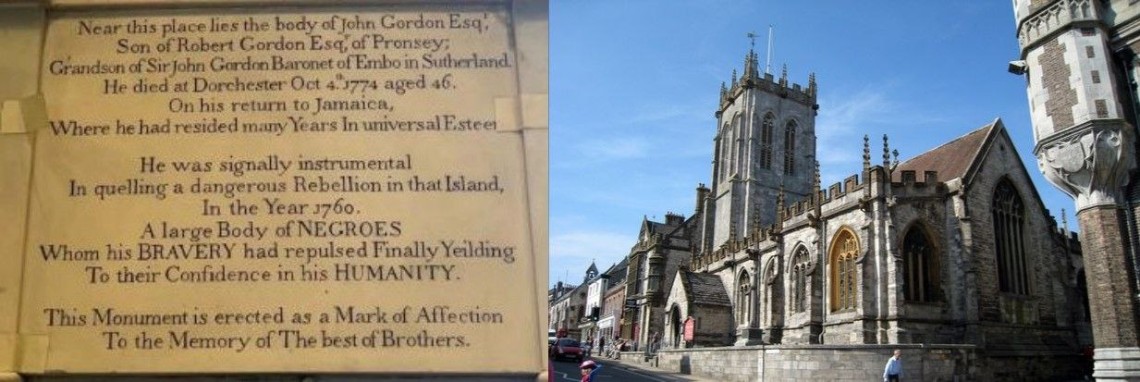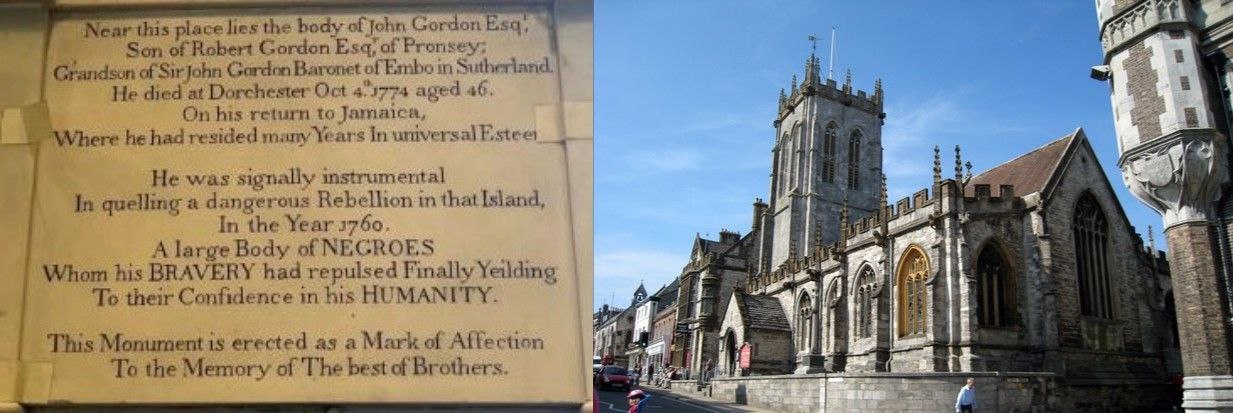Dorchester Church Removes Plaque To British Man Who Fought Against Jamaican Rebellion
by TBG

St Peter's Church in Dorchester has removed a memorial from its walls because its language is rooted in an earlier historical and moral age that progressives cannot accept today.
John Gordon was en-route to Falmouth to return to his Jamaican plantation when he dropped dead in Dorchester. He had come to Britain to write his will and put his affairs in order. A memorial plaque was erected in the church there to recognise his contribution to quelling an African rebellion in the colony in 1760.
There were about 10,000 Europeans in Jamaica at the time, including women and children and they could have been in grave danger. A not insignificant number of these were originally White indentured servants, often from Ireland and Scotland, sent by Cromwell and later Charles II.
In the 1790s, as an outline of what could have occurred, nearby Haiti (Hispaniola) revolted and 75,000 French citizens were murdered. A great many women and children were among those violated and put through the most bestial tortures. Although Haiti hasn't seen any European oversight since, it is currently undergoing another period of utter barbarism and cannibalism from warring groups 220+ years later.
The British had only overrun the Spanish Jamaican colony in 1655, after failing to take the larger Hispaniola (Haiti) nearby. They invited buccaneers to settle, to help fight back against the Spanish galleons and to protect the island.
In April, 1760 'Takyi's Revolt', an uprising by a captured African noble of Fante (Ghanaian) descent began. The Fante had themselves been slavers, though much less successfully than their tribal enemies the Ashantis, who far excelled them. Consequently, many of those who ended up on slave ships were of Fante origin. Takyi became one of these after coming off second best in a battle with the Dutch and Ashantis.
They initially rose up and murdered the White staff at the Frontier and Trinity plantations and several other locations. Some they butchered as they slept before drinking their blood. Sixty Europeans would die by the end. Esher, another nearby estate also rebelled and joined the rebel forces. Then they overran a fort and stole its gunpowder and guns. For courage and false confidence, they were covered in fairy dust by African witch doctors who now convinced them of their invincibility. They numbered about 400, by this stage.
A British force, the 74th Regiment, backed up by Jamaican Maroons took after them. The Maroons (Spanish: wild or untamed) were African-origin slaves who had rebelled and become free under the Spanish and who had later signed a treaty with the British. While the British slept, Takyi's men attacked and several more Whites were killed and Takyi himself was wounded. The rebels then escaped to the woods.
To dishearten the African rebels a witch doctor, who in modern parlance 'died suddenly' was placed near the rebel base, complete with all his protective talismans to show their vulnerability. They were then pursued. A Maroon sharpshooter took out their leader Takyi and removed his head as proof of his death. Others were soon routed and the Maroons collected 17 pairs of ears for the same purpose. The British forces then combined with them and attacked, killing twenty rebels and capturing 200. Many of their leaders were later tried and hanged, burnt, or just left suspended in the air until they starved to death.
This was the background to the John Gordon memorial in Dorchester Church and to which skirmishes he had meaningfully contributed.
As can be seen, this is a story from an age of different moral priorities, where different peoples competed against each other for dominance, sometimes with terrible results. The righteousness of his actions for the time were recognised by society at large and the church - arguably an institution with a deeper theological underpinning than the modern Church of England - and a plaque was erected to his memory.
In 2022, progressives complained about what they saw as the conflicting moral questions involved. This was in part driven by the social contagion of the Black Lives Matter charlatans and the anarchists who had toppled a statue in Bath and walked scott-free. The progressive chorus now began to demand that the memorial be removed.
On the one hand, there was general enthusiasm among these complainants that the memorial mentioned that the African captives had risen up against the progressives' own British people, with a significant rebellion killing many. But the triumphant language which discussed the rebellion being put down was problematic for them.
The plaque suggested that Gordon “was signally instrumental in quelling a dangerous rebellion in the island in the year 1760. A large body of negroes, whom his bravery had repulsed, finally yielding to their confidence in his humanity”.
After consultations, both Historic England and The Georgian Society wanted it to remain, but with a contextual plaque. So did a (BLM-supporting) direct descendant of Gordon. The church was not satisfied with this and so the vicar, Keith Magee, passed the decision on. The church brought in the Chancellor of the diocese of Salisbury - also a professional lawyer at the Nigerian chambers of Oba Nsugbe - called Ruth Arlow.
This did the trick. Ms. Arlow declared that “The monument celebrated in the language of acclamation the violent quelling of a rebellion by enslaved people against a status that is now universally acknowledged as morally repugnant and contrary to Christian doctrine. Its continued presence in the building seemed to imply the continued support, or at least toleration and acceptance, of discrimination and oppression and was inconsistent with the message of the universality of God’s love which the community of St Peter’s sought to share.”
This was the fig leaf the church was looking for. Later last year, St Peter’s greeted this (as good as pre-ordained) decision as “the most appropriate outcome.”
This week, the plaque has finally been torn off the wall and moved to a small museum down the road. Reports suggest it will only now be available to view on special request and under a beady gaze.
The church, in a sop to critics, has proposed erecting some later memorial element to Gordon without mention of the negative associations. As the timing or nature of this proposal has not been outlined, we will not be holding our breath.
Further articles to read here. Have an opinion on what you've read? Please leave a comment below.
